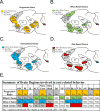Neural substrates underlying effort, time, and risk-based decision making in motivated behavior
- PMID: 27427327
- PMCID: PMC5007005
- DOI: 10.1016/j.nlm.2016.07.015
Neural substrates underlying effort, time, and risk-based decision making in motivated behavior
Abstract
All mobile organisms rely on adaptive motivated behavior to overcome the challenges of living in an environment in which essential resources may be limited. A variety of influences ranging from an organism's environment, experiential history, and physiological state all influence a cost-benefit analysis which allows motivation to energize behavior and direct it toward specific goals. Here we review the substantial amount of research aimed at discovering the interconnected neural circuits which allow organisms to carry-out the cost-benefit computations which allow them to behave in adaptive ways. We specifically focus on how the brain deals with different types of costs, including effort requirements, delays to reward and payoff riskiness. An examination of this broad literature highlights the importance of the extended neural circuits which enable organisms to make decisions about these different types of costs. This involves Cortical Structures, including the Anterior Cingulate Cortex (ACC), the Orbital Frontal Cortex (OFC), the Infralimbic Cortex (IL), and prelimbic Cortex (PL), as well as the Baso-Lateral Amygdala (BLA), the Nucleus Accumbens (NAcc), the Ventral Pallidal (VP), the Sub Thalamic Nucleus (STN) among others. Some regions are involved in multiple aspects of cost-benefit computations while the involvement of other regions is restricted to information relating to specific types of costs.
Keywords: Behavioral activation; Cost-benefit computation; Delay-discounting; Effort-based decision making; Motivation; Risk-discounting.
Copyright © 2016 Elsevier Inc. All rights reserved.
Figures





References
-
- Anaclet C, Parmentier R, Ouk K, Guidon G, Buda C, Sastre JP, Lin JS. Orexin/Hypocretin and Histamine: Distinct Roles in the Control of Wakefulness Demonstrated Using Knock-Out Mouse Models. The Journal of Neuroscience. 2009;29(46):14423–14438. doi: 10.1523/jneurosci.2604-09.2009. - DOI - PMC - PubMed
-
- Antle MC, Silver R. Circadian Insights into Motivated Behavior. Berlin, Heidelberg: Springer Berlin Heidelberg; 2015. pp. 1–33. - PubMed
Publication types
MeSH terms
Grants and funding
LinkOut - more resources
Full Text Sources
Other Literature Sources

